History
The first modern settlements were established here between the 10th and 12th centuries. During the Mongol invasion of Poland and other Mongol/Tatar raids of the early Kingdom of Poland, residents of Lesser Poland escaped to the dense forest to save themselves from Asiatic hordes. Sandomierz Forest remained sparsely populated until the mid-14th century, when King Casimir III the Great initiated a program of mass settlement, founding several towns. In the 15th and 16th centuries, northern and central areas of the forest were settled by peasants from overpopulated province of Mazovia. In the 17th century, during the Swedish invasion of Poland, local residents again escaped to the forest from Swedish, Cossack, Tatar and Transilvanian invaders.
After the Partitions of Poland, the forest became part of newly formed Austrian Galicia. In the late 18th and early 19th centuries, Austrian government invited German-speaking settlers (the so-called Josephine colonization, after Joseph II, Holy Roman Emperor). The area turned into a melting pot, where ethnic Poles from Mazovia and Lesser Poland mixed with Germans, Ukrainians, Tatars, Jews, Wallachians and other nationalities. Several local villages were named after different ethnic groups: Rusiny, Moskale, Mazury, Wolochy, Szwedy, Turki, Tatary. In the late 19th century, inhabitants of the wilderness began to call themselves Lasowiacy (or Lesioki).

Lesser Poland, often known by its Polish name Małopolska, is a historical region situated in southern and south-eastern Poland. Its capital and largest city is Kraków. Throughout centuries, Lesser Poland developed a separate culture featuring diverse architecture, folk costumes, dances, cuisine, traditions and a rare Lesser Polish dialect. The region is rich in historical landmarks, monuments, castles, natural scenery and UNESCO World Heritage Sites.

The Deluge was a series of mid-17th-century military campaigns in the Polish–Lithuanian Commonwealth. In a wider sense, it applies to the period between the Khmelnytsky Uprising of 1648 and the Truce of Andrusovo in 1667, comprising the Polish theatres of the Russo-Polish and Second Northern Wars. In a stricter sense, the term refers to the Swedish invasion and occupation of the Commonwealth as a theatre of the Second Northern War (1655–1660) only; in Poland and Lithuania this period is called the Swedish Deluge, or less commonly the Russo–Swedish Deluge due to the simultaneous Russo-Polish War. The term "deluge" was popularized by Henryk Sienkiewicz in his novel The Deluge (1886).
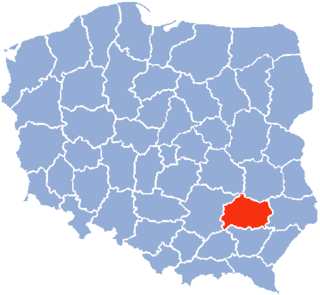
The Tarnobrzeg Voivodeship was a unit of administrative division and local government in Poland in years 1975-1998, superseded in parts by Subcarpathian Voivodeship, Świętokrzyskie Voivodeship and Lublin Voivodeship. Its capital city was Tarnobrzeg, although the major city in the region was Stalowa Wola.

Tarnobrzeg is a city in south-eastern Poland, on the east bank of the river Vistula, with 49,419 inhabitants, as of 31 December 2009. Situated in the Subcarpathian Voivodeship since 1999, it had previously been the capital of Tarnobrzeg Voivodeship (1975–1998). Tarnobrzeg lies in the Sandomierz Basin, and directly borders the town of Sandomierz, Świętokrzyskie Voivodeship. Its history dates back to the year 1593, when it was granted Magdeburg rights, and belonged to the Tarnowski family. For centuries Tarnobrzeg remained a small town, which did not develop until the post-World War II period, when it became center of an industrial area, based on rich sulfur deposits.

Stalowa Wola is the largest city and capital of Stalowa Wola County with a population of 58,545 inhabitants, as at 31 December 2021. It is located in southeastern Poland in the Subcarpathian Voivodeship. The city lies in historic Lesser Poland near the confluence of the Vistula and the San rivers, and covers an area of 82.5 km2 (31.9 sq mi). Stalowa Wola is one of the youngest cities of Poland. It was built from scratch in the late 1930s in the forests surrounding village of Pławo. The city was designed to be a settlement for workers of Huta Stalowa Wola, a plant built as part of the Central Industrial Region. The name "Stalowa Wola" translates to "Steel Will" in English, reflecting its origins and purpose as a city established to support the steel industry. Stalowa Wola is home to the sports club Stal Stalowa Wola.

Niskopronounced[ˈɲiskɔ] is a town in Nisko County, Subcarpathian Voivodeship, Poland on the San River, with a population of 15,534 inhabitants as of 2 June 2009. Together with neighbouring city of Stalowa Wola, Nisko creates a small agglomeration. Nisko has been situated in the Subcarpathian Voivodship since 1999.

Ropczyce is a town in the Subcarpathian Voivodeship in south-eastern Poland, situated in the valley of the Wielopolka River. The town has a population of 15,098. and is the seat of Ropczyce-Sędziszów County.
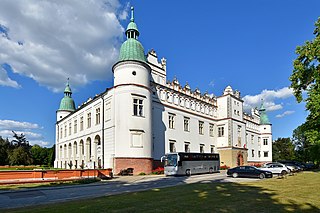
Baranów Sandomierski is a small town in southern Poland, in the Subcarpathian Voivodship, Tarnobrzeg County on the Vistula River, with 1,420 inhabitants as of December 2021. Baranów lies near the Vistula river, along voivodeship road nr. 985, which goes from Tarnobrzeg to Mielec. It belongs to the historic province of Lesser Poland, and for centuries was part of the Sandomierz Voivodeship. Its name comes either from sheep husbandry, which was prevalent in this area in the past, or from the Baranowski family, owners of the town.
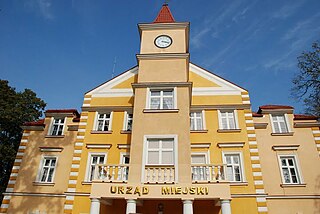
Dębica is a town in southeastern Poland with 44,692 inhabitants as of December 2021. It is the capital of Dębica County. Since 1999 it has been situated in the Podkarpackie Voivodeship; it had previously been in the Tarnów Voivodeship (1975–1998). Dębica belongs to the historic province of Lesser Poland, and for centuries it was part of the Sandomierz Voivodeship.
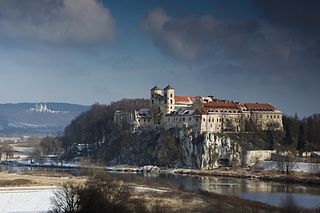
Tyniec is a historic village in Poland on the Vistula river, since 1973 a part of the city of Kraków. Tyniec is notable for its Benedictine abbey founded by King Casimir the Restorer in 1044.

Iłża is a small town in Masovian Voivodeship, Poland. In 2006 Iłża had approximately 5,165 inhabitants. The town belongs to the historical region of Lesser Poland, and from its foundation until 1795, it was part of Lesser Poland’s Sandomierz Voivodeship. Iłża lies in Małopolska Upland, on the Iłżanka river, 30 kilometers south of Radom.
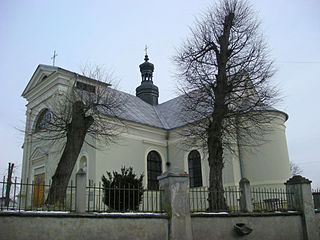
Osiek is a town in Staszów County, Świętokrzyskie Voivodeship, Poland, with 2,001 inhabitants (2010). The town lies in Lesser Poland, along the National Road nr. 79, which goes from Warsaw to Bytom. Osiek is located 15 kilometers northeast of Połaniec, and 18 kilometers west of Tarnobrzeg, 180 meters above sea level.

Koprzywnica is a town in Sandomierz County, Świętokrzyskie Voivodeship, Poland, with 2,546 inhabitants (2004). Koprzywnica lies on the Koprzywianka river, in Lesser Poland. It is one of the oldest urban centers of the province, located along the Tarnobrzeg Route of historic Lesser Polish Way of St. James, and on the National Road Nr. 79, which goes from Kraków to Sandomierz.
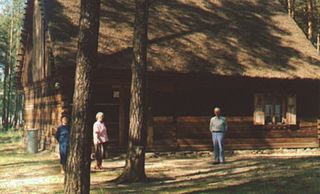
Kurpie is one of a number of ethnic regions in Poland, noted for its unique traditional customs, such as its own types of traditional costume, traditional dance and distinctive type of architecture and livelihoods. Kurpie is also the name of the people of this culture.

Sandomierz Basin is a lowland, located in southeastern Poland, between the Lesser Poland Upland, Lublin Upland and the Western Carpathians. Its name comes from the historical city of Sandomierz, and the basin has a triangular shape with the size of around 15,000 km2 (5,800 sq mi). It is drained by the Vistula River, as well as its eastern tributary, the San. Among major cities located in the Sandomierz Basin are Dębica, Jarosław, Mielec, Przemyśl, Przeworsk, Rzeszów, Stalowa Wola, Sandomierz, Tarnobrzeg, and Tarnów.
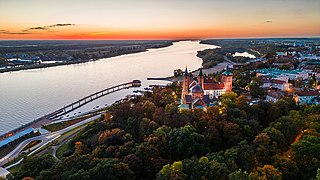
Mazovia or Masovia is a historical region in mid-north-eastern Poland. It spans the North European Plain, roughly between Łódź and Białystok, with Warsaw being the unofficial capital and largest city. Throughout the centuries, Mazovia developed a separate sub-culture featuring diverse folk songs, architecture, dress and traditions different from those of other Poles.
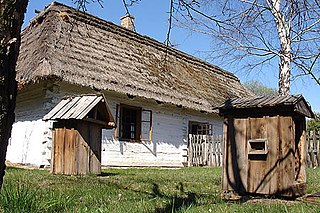
Lasovians are a subethnic group of the Polish nation, who reside in Lesser Poland, at the confluence of the Vistula and the San rivers, Subcarpathian Voivodeship, southeastern Poland. They are descended from various ethnic groups, which settled in the dense Sandomierz Forest across centuries, with a dominant Polish element. The Lasowiacy were formed as a separate subethnic group in the late 19th and early 20th century. They use their own dialect, which belongs to Lesser Polish dialect cluster of the Polish language. Like most Poles, the Lasowiacy are Roman Catholics.
History of Tarnobrzeg – In the late 16th century, the area of current Tarnobrzeg, Subcarpathian Voivodeship, Poland emerged as a local center of industry, with several bloomeries mentioned here in 1565. The Tarnowski family sold the products of the bloomeries in Sandomierz and Baranów Sandomierski, deciding that the best solution for the family business would be to establish its own independent urban center. On May 28, 1593, King Zygmunt III Waza granted Magdeburg rights to the family village, with permission to stock wine, to make two fairs a year, as well as two markets a week, on Tuesdays and Fridays. Tarnodwor, as the town was called, was located on a plain near the Vistula river, in the middle of the large family estate, near the Dzików Castle.

The second Mongol invasion of Poland was carried out by General Boroldai (Burundai) of the Golden Horde in 1259–1260. During this invasion the cities of Sandomierz, Kraków, Lublin, Zawichost, and Bytom were sacked by the Mongols for the second time.
The Sandomierzacy are a ethnographic group of the Polish nation, who reside in the historic province of Lesser Poland, around the town of Sandomierz. They use their own dialect, which belongs to Lesser Polish dialect of the Polish language. Like most Poles, the Sandomierzacy are Roman Catholics.



















